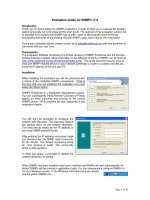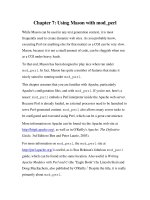Chapter 7 v7 0 accessible
Bạn đang xem bản rút gọn của tài liệu. Xem và tải ngay bản đầy đủ của tài liệu tại đây (2.18 MB, 78 trang )
Computer Networking: A Top Down
Approach
Seventh Edition
Chapter 7
Wireless and Mobile
Networks
Copyright © 2017, 2013, 2010 Pearson Education, Inc. All Rights Reserved
Wireless and Mobile Networks
Background:
• # wireless (mobile) phone subscribers now exceeds # wired
phone subscribers (5-to-1)!
• # wireless Internet-connected devices equals # wireline
Internet-connected devices
– laptops, Internet-enabled phones promise anytime
untethered Internet access
• two important (but different) challenges
– wireless: communication over wireless link
– mobility: handling the mobile user who changes point of
attachment to network
Copyright © 2017, 2013, 2010 Pearson Education, Inc. All Rights Reserved
Learning Objectives (1 of 6)
7.1 Introduction
Mobility
Wireless
7.5 Principles: addressing and
routing to mobile users
7.2 Wireless links, characteristics
– CD MA
7.6 Mobile IP
7.3 IEEE 802.11 wireless LANs
(“Wi-Fi”)
7.7 Handling mobility in cellular
networks
7.4 Cellular Internet Access
– architecture
– standards (e.g., 3G, LTE)
7.8 Mobility and higher-layer
protocols
Copyright © 2017, 2013, 2010 Pearson Education, Inc. All Rights Reserved
Elements of a Wireless Network (1 of 5)
Copyright © 2017, 2013, 2010 Pearson Education, Inc. All Rights Reserved
Elements of a Wireless Network (2 of 5)
Copyright © 2017, 2013, 2010 Pearson Education, Inc. All Rights Reserved
Elements of a Wireless Network (3 of 5)
Copyright © 2017, 2013, 2010 Pearson Education, Inc. All Rights Reserved
Characteristics of Selected Wireless Links
Copyright © 2017, 2013, 2010 Pearson Education, Inc. All Rights Reserved
Elements of a Wireless Network (4 of 5)
Copyright © 2017, 2013, 2010 Pearson Education, Inc. All Rights Reserved
Elements of a Wireless Network (5 of 5)
ad hoc mode
• No base stations
• Nodes can only transmit to
other nodes within link
coverage
ã Nodes organize
themselves into a network:
route among themselves
Copyright â 2017, 2013, 2010 Pearson Education, Inc. All Rights Reserved
Wireless Network Taxonomy
Blank
Infrastructure
(e.g.,APs)
No infrastructure
Single hop
Host connects to
base station (WiFi,
WiMAX, cellular)
which connects to
larger Internet
No base station, no
connection to larger
Internet (Bluetooth,
ad hoc nets)
Multiple hops
Host may have to relay
through several wireless
nodes to connect to
larger Internet: mesh net
No base station, no
connection to larger
Internet. May have to
relay to reach other
a given wireless node M
ANET, VANET
Copyright © 2017, 2013, 2010 Pearson Education, Inc. All Rights Reserved
Learning Objectives (2 of 6)
7.1 Introduction
Mobility
Wireless
7.5 Principles: addressing and
routing to mobile users
7.2 Wireless links, characteristics
– CD MA
7.6 Mobile IP
7.3 IEEE 802.11 wireless LANs
(“Wi-Fi”)
7.7 Handling mobility in cellular
networks
7.4 Cellular Internet Access
– architecture
– standards (e.g., 3G, LTE)
7.8 Mobility and higher-layer
protocols
Copyright © 2017, 2013, 2010 Pearson Education, Inc. All Rights Reserved
Wireless Link Characteristics (1 of 2)
Important differences from wired link ….
• Decreased signal strength: radio signal attenuates as it
propagates through matter (path loss)
• Interference from other sources: standardized wireless
network frequencies (e.g., 2.4 G H z) shared by other
devices (e.g., phone); devices (motors) interfere as well
iga
ert
• Multipath propagation: radio signal reflects off objects
ground, arriving ad destination at slightly different times
…. make communication across (even a point to point)
wireless link much more “difficult”
Copyright © 2017, 2013, 2010 Pearson Education, Inc. All Rights Reserved
Wireless Link Characteristics (2 of 2)
• SNR: signal-to-noise ratio
– Larger SNR – easier to extract
signal from noise (a “good thing”)
• SNR versus BER tradeoffs
– given physical layer: increase
power -> increase SNR ->decrease
B ER
– given SNR: choose physical layer
that meets BER requirement, giving
highest thruput
▪ SNR may change with mobility:
dynamically adapt physical layer
(modulation technique, rate)
Copyright © 2017, 2013, 2010 Pearson Education, Inc. All Rights Reserved
Wireless Network Characteristics (1 of 2)
Multiple wireless senders and receivers create additional
problems (beyond multiple access):
Copyright © 2017, 2013, 2010 Pearson Education, Inc. All Rights Reserved
Wireless Network Characteristics (2 of 2)
Hidden terminal problem
• B, A hear each other
• B, C hear each other
• A, C can not hear each other means A, C unaware of
their interference at B
Signal attenuation:
• B, A hear each other
• B, C hear each other
• A, C can not hear each other interfering at B
Copyright © 2017, 2013, 2010 Pearson Education, Inc. All Rights Reserved
Code Division Multiple Access (CDMA)
• Unique “code” assigned to each user; i.e., code set
partitioning
– all users share same frequency, but each user has
own “chipping” sequence (i.e., code) to encode data
– allows multiple users to “coexist” and transmit
simultaneously with minimal interference (if codes are
“orthogonal”)
• Encoded signal = (original data) X (chipping sequence)
ã Decoding: inner-product of encoded signal and chipping
sequence
Copyright â 2017, 2013, 2010 Pearson Education, Inc. All Rights Reserved
CDMA Encode/Decode
Copyright © 2017, 2013, 2010 Pearson Education, Inc. All Rights Reserved
CDMA: Two-Sender Interference
Copyright © 2017, 2013, 2010 Pearson Education, Inc. All Rights Reserved
Learning Objectives (3 of 6)
7.1 Introduction
Mobility
Wireless
7.5 Principles: addressing and
routing to mobile users
7.2 Wireless links, characteristics
– CD MA
7.6 Mobile IP
7.3 IEEE 802.11 wireless LANs
(“Wi-Fi”)
7.7 Handling mobility in cellular
networks
7.4 Cellular Internet Access
– architecture
– standards (e.g., 3G, LTE)
7.8 Mobility and higher-layer
protocols
Copyright © 2017, 2013, 2010 Pearson Education, Inc. All Rights Reserved
IEEE 802.11 Wireless LAN
802.11b
802.11g
• 2.4-5 G H z unlicensed spectrum
• 2.4-5 G H z range
• up to 11 Mbps
• up to 54 Mbps
• direct sequence spread spectrum
(DSSS) in physical layer
– all hosts use same chipping
code
802.11n: multiple antennae
iga
ert
802.11a
• 5-6 G H z range
iga
ert
• up to 54 Mbps
iga
ert
• 2.4-5 G H z range
iga
ert
• up to 200 Mbps
• all use CSMA/CA for
multiple access
• all have base-station and
ad-hoc network versions
Copyright © 2017, 2013, 2010 Pearson Education, Inc. All Rights Reserved









